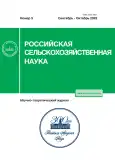Optimization of technological operations in the cultivation of field crops in arid conditions of the Volga Region
- Authors: Goryanin O.I1, Dzhangabaev B.Z.1, Shcherbinina E.V1, Pronovich L.V1
-
Affiliations:
- Samara Federal Research Scientific Center RAS
- Issue: No 5 (2023)
- Pages: 34-38
- Section: Articles
- URL: https://journals.rcsi.science/2500-2627/article/view/233868
- DOI: https://doi.org/10.31857/S250026272305006X
- EDN: https://elibrary.ru/PKZQKR
- ID: 233868
Cite item
Full Text
Abstract
Keywords
About the authors
O. I Goryanin
Samara Federal Research Scientific Center RAS
Email: gorjanin.oleg@mail.ru
3a, Studencheskiy pereulok, Samara, 443001
B. Zh. Dzhangabaev
Samara Federal Research Scientific Center RAS3a, Studencheskiy pereulok, Samara, 443001
E. V Shcherbinina
Samara Federal Research Scientific Center RAS3a, Studencheskiy pereulok, Samara, 443001
L. V Pronovich
Samara Federal Research Scientific Center RAS3a, Studencheskiy pereulok, Samara, 443001
References
- О целесообразности освоения системы прямого посева на чернозёмах России / А. Л. Иванов, В. В. Кулинцев, В. К. Дридигер и др. // Достижения науки и техники АПК. 2021. Т. 35. № 4. С. 8-16. doi: 10.24411/0235-2451-2021-10401.
- Экономическая эффективность возделывания яровой пшеницы по технологиям прямого посева в условиях Среднего Поволжья / А. Л. Тойгильдин, М. И. Подсевалов, И. А. Тойгильдина и др. // Нива Поволжья. 2022. № 3 (63). С. 1006. doi: 10.36461/NP.2022.63.3.011.
- Agrotechnological Fundamentals of Direct Sowing of Grain Crops in Russia's Arid Conditions / O. I. Goryanin, S. N. Zudilin, I. F. Medvedev, et al. // Revista geintec-gestao inovacao e tecnologias. 2021. Vol. 11. No. 2. P. 204-215. doi: 10.47059/revistageintec.v11i2.1654.
- Crop rotation and residue management effects on soil enzyme activities, glomalin and aggregate stability under zero tillage in the Indo-Gangetic Plains / G. Singh, R. Bhattacharyya, T. K. Das, et al. // Soil and Tillage Research. 2018. Vol. 184. P. 291-300. doi: 10.1016/j.still.2018.08.006.
- Rehabilitation of soil properties by using direct seeding technology / V. K. Dridiger, A. L. Ivanov, V. P. Belobrov, et al. // Eurasian Soil Science. 2020. Vol. 53. No. 9. P. 1293-1301. doi: 10.1134/S1064229320090033.
- Skaalsveen K., Ingram J., Clarke L. E. The effect of no-till farming on the soil functions of water purification and retention in northwestern Europe: а literature review // Soil & Tillage research. 2019. Vol. 189. Р. 98-109. doi: 10.1016/j.still.2019.01.004.
- Изменение физических свой ств черноземов при прямом посеве / В. П. Белобров, С. А. Юдин, Н. В. Ярославцева и др. // Почвоведение. 2020. № 7. С. 880-890. doi: 10.31857/S0032180X20070023.
- Blanco-Canqui H., Ruis S. J. No-tillage and soil physical environment // Geoderma. 2018. Vol. 326. P. 164-200. doi: 10.1016/j.geoderma.2018.03.011.
- Residue retention and minimum tillage improve physical environment of the soil in croplands: A global meta-analysis / Y Li, Z. Li, S. Cui, et al. // Soil and Tillage Research. 2019. Vol. 194. P. 104-292. doi: 10.1016/j.still.2019.06.009.
- Приказ Министерства сельского хозяйства РФ от 6 июля 2017 г. № 330 "Об утверждении коэффициентов перевода в зерновые единицы сельскохозяйственных культур". URL: https://www.garant.ru/products/ipo/prime/doc/71634802/ (дата обращения: 15.05.2023)
- Шафран С. А. Вклад минеральных удобрений в формирование урожайности полевых культур. Сообщение 1. Азотные удобрения // Агрохимия. 2021. № 7. С. 27-35. doi: 10.31857/S0002188121070097.
- Корчагин В. А., Горянин О. И., Новиков В. Г. Прямой посев яровой мягкой пшеницы в степных районах Среднего Поволжья // Достижения науки и техники АПК. 2007. № 8. С. 17-19.
- Эффективность применения удобрений в засушливых условиях Поволжья / О. И. Горянин, С. В. Обущенко, Б. Ж. Джангабаев и др. //Земледелие. 2020. № 8. С. 29-33. doi: 10.24411/0044-3913-2020-10806.
Supplementary files









